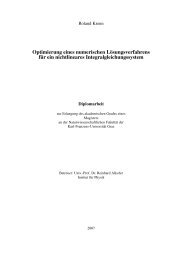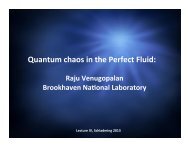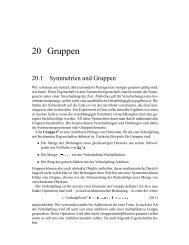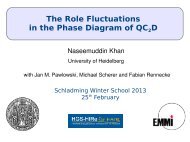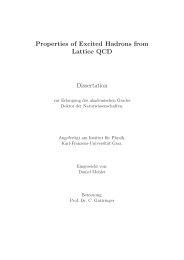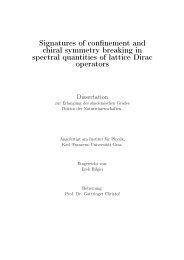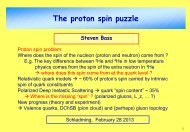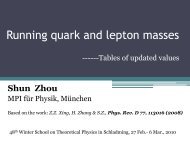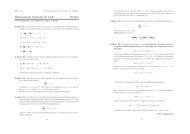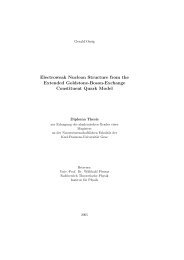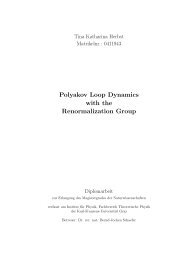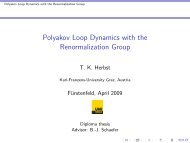The QCD Quark Propagator in Coulomb Gauge and - Institut für Physik
The QCD Quark Propagator in Coulomb Gauge and - Institut für Physik
The QCD Quark Propagator in Coulomb Gauge and - Institut für Physik
You also want an ePaper? Increase the reach of your titles
YUMPU automatically turns print PDFs into web optimized ePapers that Google loves.
Chapter 6. Nucleon Form Factors <strong>in</strong> a Covariant Diquark-<strong>Quark</strong> model 57<br />
for the nucleon <strong>and</strong> ∆ that are vital for our analysis, <strong>and</strong> present the solutions. Section<br />
6.4 describes the formulation of a Ward-Takahashi identity preserv<strong>in</strong>g current that is<br />
appropriate to a nucleon represented by a solution of the Faddeev equation. With the necessary<br />
elements thus specified, the results for the nucleons’ electromagnetic form factors<br />
are presented <strong>and</strong> discussed <strong>in</strong> section 6.5.<br />
6.2 Two-quark correlations<br />
In the preced<strong>in</strong>g section we po<strong>in</strong>ted out that by us<strong>in</strong>g the concept of diquarks we effectively<br />
assume the two-quark correlation matrix to be separable. As this approximation is ma<strong>in</strong>ly<br />
borrowed from the Nambu-Jona-Las<strong>in</strong>io (NJL) model, we will describe how diquarks arise<br />
there <strong>and</strong> how the diquark-quark picture is realized <strong>in</strong> other models.<br />
It is well-known that a separable two-quark correlation matrix arises from a separable<br />
four-quark scatter<strong>in</strong>g kernel. In <strong>QCD</strong> already the simplest contribution <strong>in</strong> the perturbative<br />
kernel, the gluon exchange, has a non-separable form. By <strong>in</strong>troduc<strong>in</strong>g a δ-function<br />
<strong>in</strong> configuration space for the gluon propagator a NJL model with po<strong>in</strong>tlike four-quark<br />
<strong>in</strong>teraction is realised. This local current-current <strong>in</strong>teraction can be expressed as an attractive<br />
<strong>in</strong>teraction <strong>in</strong> colour s<strong>in</strong>glet meson <strong>and</strong> colour triplet diquark channels [AR]. <strong>The</strong><br />
quark-quark scatter<strong>in</strong>g kernel <strong>in</strong> the scalar channel s can be written as<br />
(K s ) αβ,γδ = 4G s (χ s ) αβ (χ s ) γδ (6.2)<br />
= 4G s (γ 5 Cτ 2 λ k ) αβ (C T γ 5 τ 2 λ k ) γδ . (6.3)<br />
Here we only consider an isosp<strong>in</strong> doublet of two quarks that are <strong>in</strong> a flavour antisymmetric<br />
(τ 2 ) <strong>and</strong> a colour antitriplet state (λ k , k = 2, 5, 7) (the τ i are Pauli matrices <strong>and</strong> λ k are<br />
Gell-Mann matrices). C denotes the charge conjugation matrix <strong>and</strong> G s regulates the<br />
strength <strong>in</strong> the <strong>in</strong>teraction channel. <strong>The</strong> scalar diquark propagator can be computed to<br />
be<br />
(D s ) −1 (k 2 ) = 1<br />
4G s<br />
− 2tr D<br />
∫<br />
d 4 q<br />
γ 5 )S(q + k (2π) 4(CT 2 )(γ5 C)S T ( k − q) . (6.4)<br />
2<br />
After regularis<strong>in</strong>g the divergent <strong>in</strong>tegral the <strong>in</strong>verse propagator has zeros for certa<strong>in</strong> values<br />
of k 2 . This shows that <strong>in</strong> the NJL model bound scalar diquarks exist <strong>and</strong> the propagator<br />
can be seen as a scalar propagator, which has the effect of a dress<strong>in</strong>g quark loop<br />
<strong>in</strong>corporated.<br />
Look<strong>in</strong>g at the meson spectrum the axialvector diquarks are analogously supposed to<br />
play an important role <strong>in</strong> the diquark channel. Indeed <strong>in</strong> [WBAR93] the axialvector diquark<br />
propagator has poles, but their appearance varies with the ratio of the coupl<strong>in</strong>g



